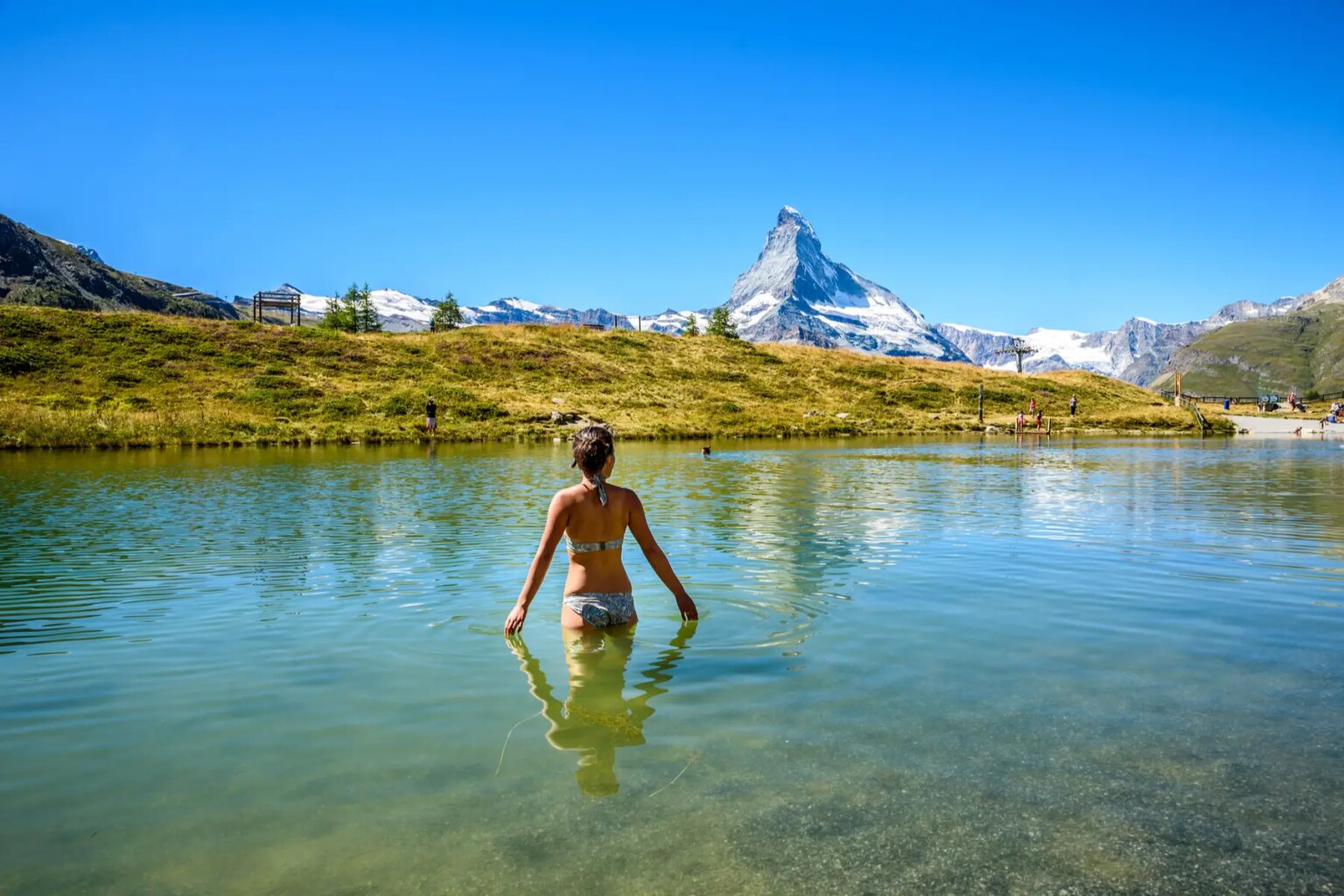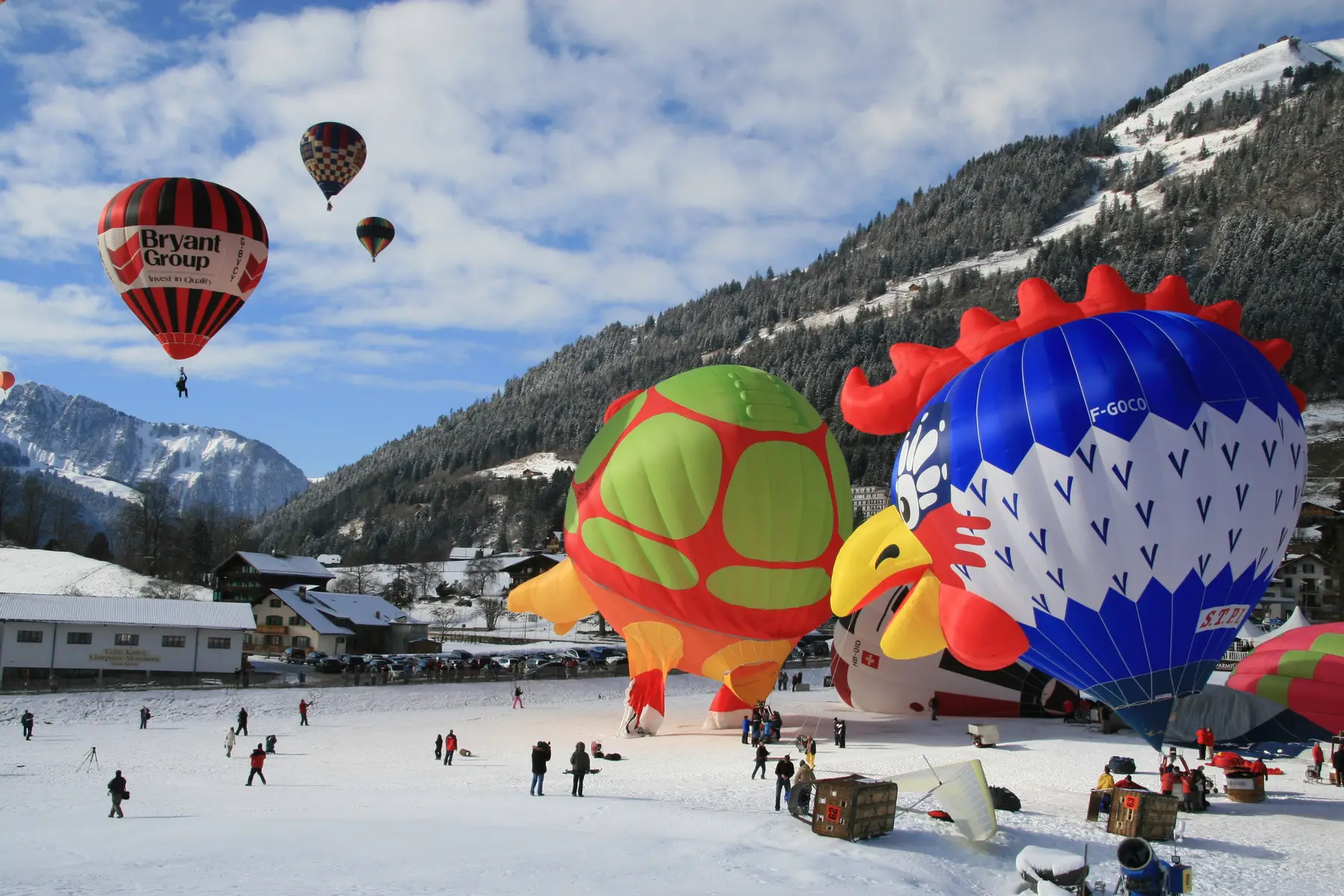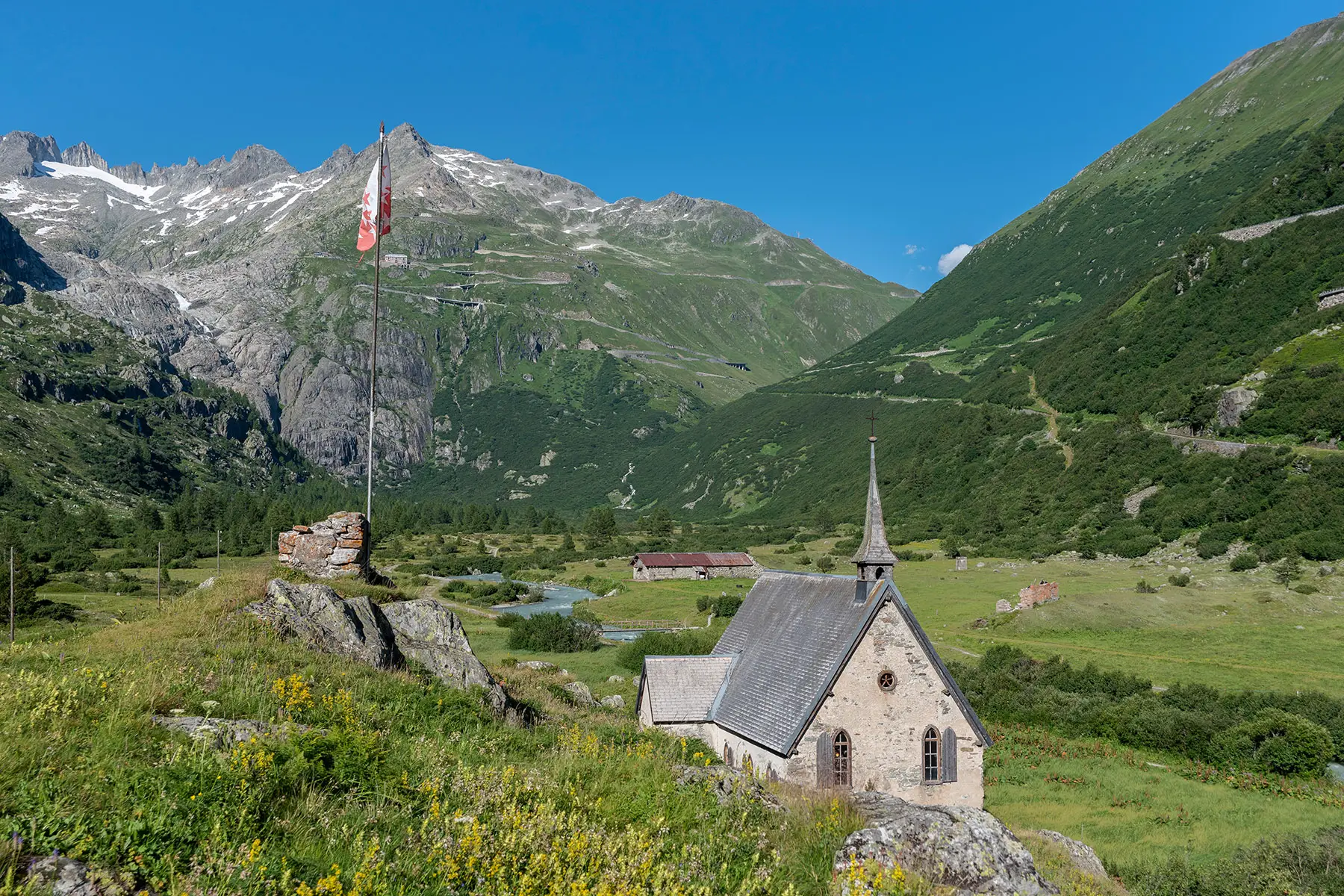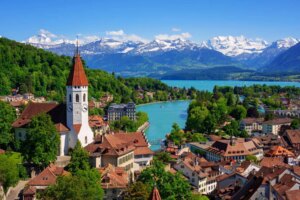Similar to other central and eastern European countries, Switzerland has a mainly continental climate with four seasons each year. This includes a generally long and cold winter and a pleasant but variable summer.
That said, the Swiss climate is subject to significant fluctuations that can vary depending on where you are in the country. This is due to the country’s unique geographical location as well as factors such as topography, elevation, and weather fronts that come into play. Therefore, as you prepare to move to Switzerland, it is important to be aware of the climatic conditions you might experience throughout the year.
Fortunately, this helpful guide is here to walk you through everything you need to know, including the following:
Sirelo
It's no secret that moving abroad can be stressful. Sirelo's team of removal advisers is here to help. They provide five free quotes from international shipping companies so you can find the best options at the best prices. Take the stress out of your relocation to Switzerland with Sirelo.
Regional climatic zones in Switzerland
Switzerland is essentially divided into three distinct climatic zones – the Alps, the Central Plateau, and the canton of Ticino. Due to varying factors such as landscape, latitude, prevailing winds, and air currents, the climate and temperatures can vary significantly throughout these zones.
The Central Plateau (or Mittelland)
The Central Plateau, also known as the Mittelland or middle country, runs across the east to the west of Switzerland; between the Jura Mountains and the Alps. This is both a climatic and geographical zone and is home to the capital, Bern, as well as the main Swiss cities of Zurich, Lausanne, and Geneva. Sitting at a mean altitude of 580 meters, the plateau covers around 30% of the country but houses more than two-thirds of its total population. It is also the center of the country’s farming industry.

The climate in the Central Plateau is moderately continental, with cold winters and often reaching freezing temperatures in January, and warm summers, with highs of around 25°C. There are two types of wind that affect the climate and temperature in the Mittelland, too. The first is the cold, dry Bise wind that blows the northeast to southwest, through the Central Plateau, and over the Alps. In the summer, this can cause dry and sunny weather; whereas, in winter, it can lead to cloudy skies and even severe ice in Geneva and neighboring communities. The second wind is the warmer and moist Alpine Foehn (or Föhn), which blows over the Alps from the Mediterranean Sea in spring. This can cause heavy storms with winds of hurricane strength.
The Alps
As you might expect, the climate in Switzerland becomes colder with increasing altitude and slope exposure. In fact, it drops about one degree Celsius with every 200 meters of elevation gain. Therefore, when you reach the Alps in the south of the country, the climate becomes more extreme. Because most of Switzerland is located on the northern side of the Alps, it also experiences lower temperatures than on the southern side.

That said, the weather in the Swiss Alps can be extremely temperamental. This is due to variations in landscape, elevation, and the different air masses that come into play. For instance, it can snow in June during cold spells but be relatively mild and sunny during winter.
Thunderstorms are also fairly frequent in some areas of the Alps during the warm season, which runs from May to September. However, there are dry pockets of land that are sheltered high up in the mountains, such as Davos and Zermatt, which are popular destinations for skiing.
The fog phenomenon
During autumn and winter, parts of the northern Alpine valleys, as well as the villages and cities of the low areas of the Mittelland, experience a climatic phenomenon in the form of a lowland fog. This occurs when the stable, high-pressure weather conditions prevail over central Europe and the Alps and create cold air masses. This results in a blanket of fog that can cover the areas for days or even weeks.
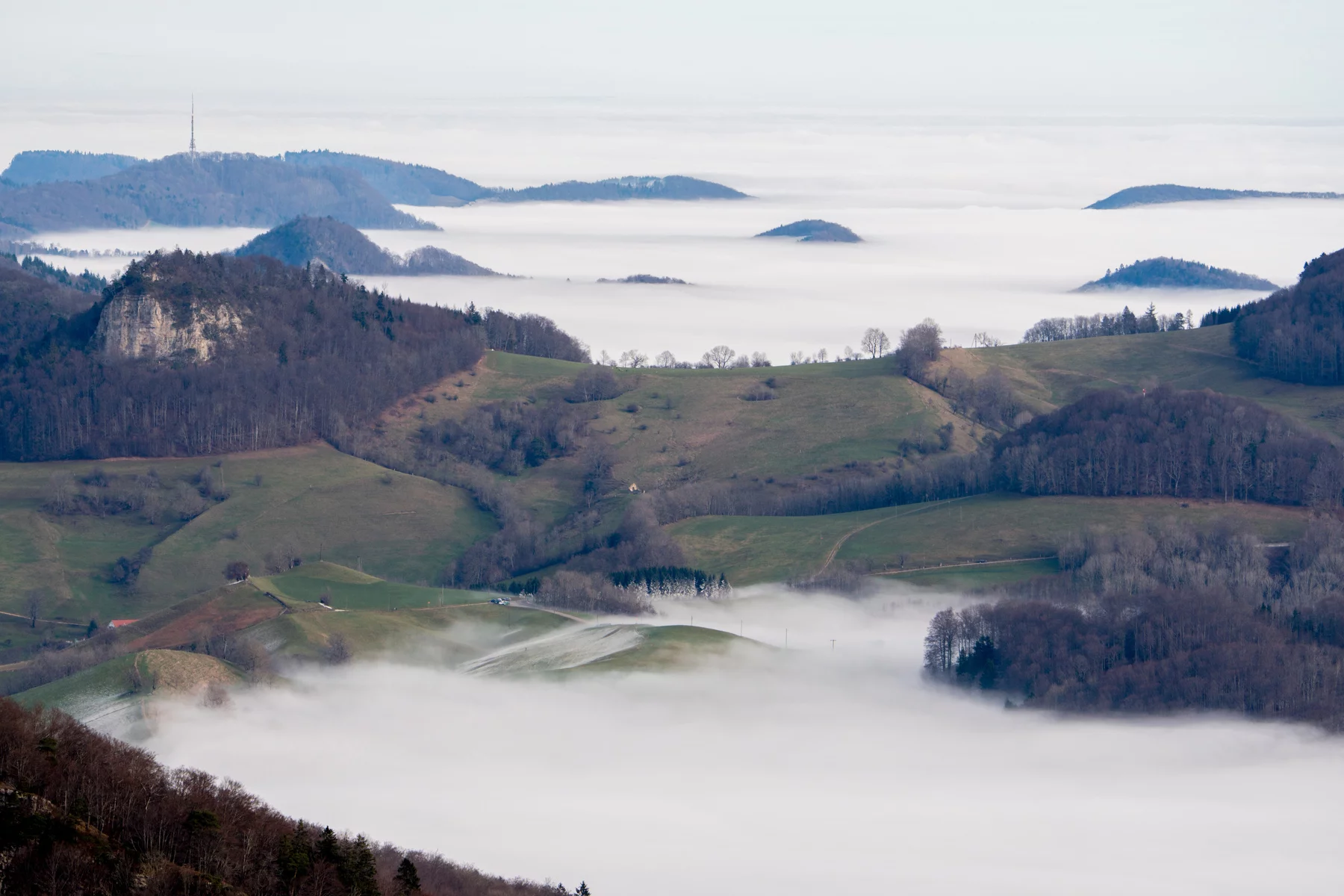
Meanwhile, towns perched high up in the Alps get to enjoy warm weather due to an inversion. This occurs when the air above the fog line is warmer than the air below. For this reason, Switzerland’s high-altitude resorts are extremely popular destinations come wintertime.
The canton of Ticino
Located just south of the Alps, on the border of Italy, Ticino is the southernmost canton of Switzerland. As you might expect, the canton shares a similar climate to its neighbor which is almost Mediterranean. In fact, Ticino is one of the warmest regions in Switzerland with an average daily high temperature of 17°C. Unsurprisingly, the canton is a major tourist destination and is famous for its rich culture and gastronomy.

From June to September, the warmer temperatures make it particularly popular among tourists and locals alike; not to mention expats seeker more comfortable climes. That said, summer can also bring about frequent afternoon thunderstorms, as well as heavy rainfall in autumn.
Climate averages in Switzerland
As mentioned, Switzerland has four distinct seasons which affect the weather and temperatures throughout the country.
Average temperatures in Switzerland
Winter is the coldest and grayest season in Switzerland, with January and February the most severe months. During this time, the temperature generally ranges from -2°C to 7°C, with only a few hours of sunlight each day. However, this can vary greatly depending on where you are. In summer, the weather is fairly pleasant, with the daytime temperature ranging from 18°C to 28°C. You’ll find the warmest temperatures in July and August. During spring and autumn, it generally ranges from 8°C to 15°C.
Average rainfall in Switzerland
Overall, Switzerland receives between 812mm and 2,387mm of rainfall throughout the year. Summer is the wettest season and late autumn to early spring is the driest. But again, precipitation varies considerably due to the different climatic zones and landscapes within the country.
The average rainfall on the Central Plateau, for instance, is between 812mm and 1,320mm. The foothills of the Alps, meanwhile, receive between 1,219mm and 1,625mm. Generally speaking, the High Alps and the southernmost canton of Ticino have the wettest conditions in the country. The average annual humidity also ranges from between 66% and 80% throughout Switzerland.
Average snowfall in Switzerland
The average snowfall also varies considerably due to the different climatic zones and landscapes. For instance, the most extreme snowfall is found on the Säntis mountain peak; this receives an annual average of 1,114cm of snow over 123 days. This stands at 2,502 meters elevation and is the highest point in the Appenzell Alps.
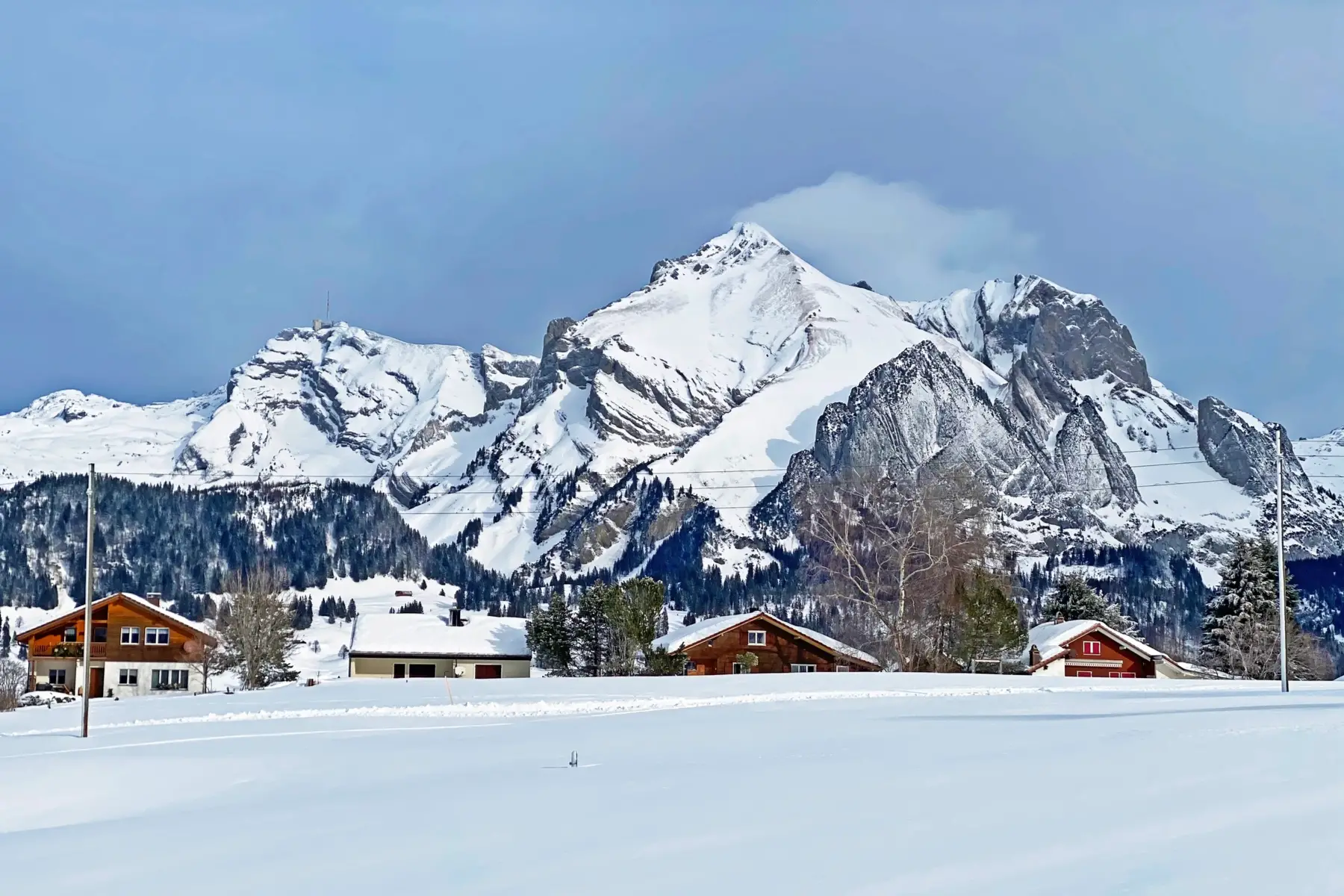
Meanwhile, Lugano, which is located in the canton of Ticino at 273 meters, only receives around 26cm each year, with an average of just four days of snowfall. Of course, for this reason, Switzerland’s popular ski resorts can be found at high altitudes. Davos, Scuol, and Samedan, for instance, all sit above 1,500 metres elevation, in the canton of Graubünden.
The seasons in Switzerland
Spring
In Switzerland, spring runs from mid-March to mid-June, with average temperatures ranging from 8°C to 15°C. These comfortable daytime temperatures allow for plenty of possibilities to explore Switzerland’s outstanding natural scenery. However, the nights can get fairly chilly, dropping as low as 5°C. The weather in spring is variable, so it might be wise to hang on to your winter coat and scarf, but leave behind your heavy winter knits. And because spring showers are guaranteed, don’t forget your umbrella, either.
Spring is a great time to explore the country’s many hiking trails while they are lined with flowering trees; all the while enjoying views of the snowy Alps in the distance. You can also catch some great Swiss festivals during the season such as Zurich’s Spring Festival, Sechseläuten, in April, and Ascension Day (Auffahrt), which falls 40 days after Easter. Of course, Easter is also the perfect time to sample some of the 180,000 tons of Swiss chocolate that is produced in Switzerland each year.
Summer
Summer begins in mid-June and ends around mid-September. The season is generally dry and warm, with humidity depending on the altitude. With mild temperatures, ranging from 18°C to 28°C, and longer days in July and August, this is also a great time of year to explore the various hiking trails, cities, and Swiss festivals.

There are many to choose from throughout the summer season. However, the highlight is undoubtedly Swiss National Day which is celebrated on 1 August. Music lovers can also enjoy two weeks of performances by some of the world’s best-known artists at the Montreux Jazz Festival. Other popular summer events include Zurich Festival, the Fête de la Musique in Geneva, the Paléo Festival in Nyon, and Gauklerfest in Interlaken.
Light dresses and cotton or linen clothing are generally the best attire for being out and about in the summer. However, just remember that it does cool down at night so you will need a light jacket or sweater, too. And, if you’re going hiking, proper hiking shoes are a must for tackling the Alpine trails. Be prepared for a cold snap at high altitudes, too. And finally, don’t get caught out by one of the frequent afternoon thunderstorms and heavy rain showers that come with the season.
Autumn
Running from September to November, autumn is the start of a quieter low season in Switzerland. During this time, even the cows return to the Swiss valleys after spending their summer grazing on the mountainside pastures. Known as Alpabfahrt (or Désalpe), this procession holds a special place in the hearts of the locals.
Those passing through these villages during this time can expect to see a parade of cows wearing flower headdresses and large jangling cowbells. Yodelers, brass bands, street fairs, and of course, crowds also join the festivities. Visitors can also stock up on all kinds of fresh local produce at the popular farmers’ markets.
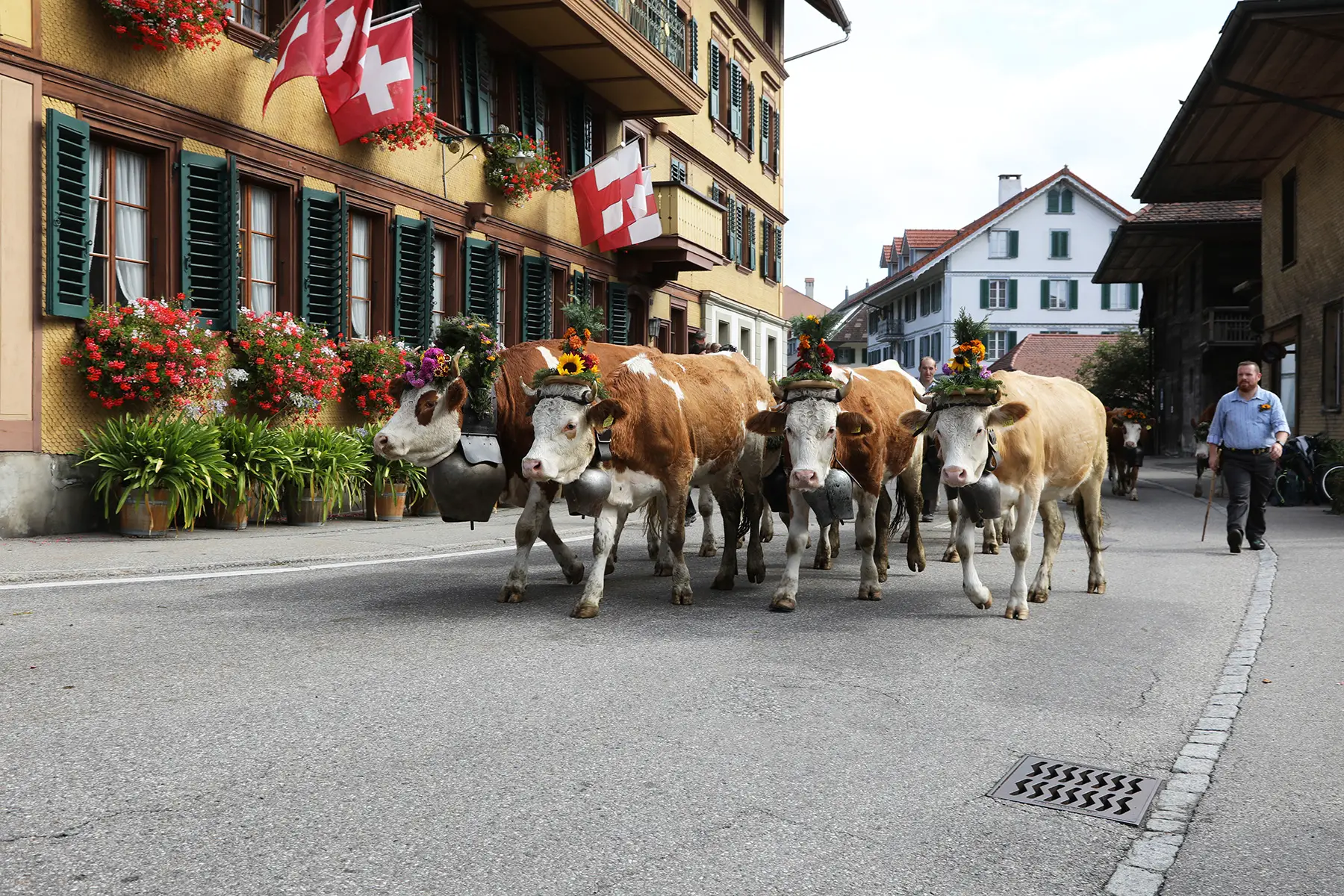
Elsewhere, the leaves on the trees change color and the fruits ripen for eating. During the season, the temperatures drop to around 8°C to 15°C, but without the winter chill and darkness that arrive later. The days begin to shorten in October. Light sweaters and jackets are perfect for the warm autumn days, but you will need to bundle up on the chillier evenings when the temperature can drop down to single digits.
This is also the foggiest time of year and, like in most of northern Europe, there will definitely be some rainy days, so be prepared. If you want to lap up some culture, then head to the three-day-long Autumn Festival in Lugano. Here, you can nibble on roasted chestnuts and sip on a variety of delicious Ticino wines at various grottos dotted around the city.
Winter
With skiing and other popular winter sports abound, winter is the season when Switzerland really shines. The Swiss snow season officially begins in January, when the weather hovers around 0°C all month and rarely exceeds 2°C. Of course, the days are shorter during winter too, with the sun setting before 17:00 until late January. Therefore, those wanting to make the most of the day should aim to hit the slopes early.

These weather conditions last until February, which brings about slightly more sunshine and great skiing conditions. By mid-March, however, the first signs of spring begin to appear. But in Switzerland, there is much more to do in the snow than just skiing. If the weather is clear, for instance, you can always hop on a train or cable car into the mountains to enjoy spectacular views. On a snowy day, you can also search for the nearest toboggan run. If you prefer hiking, however, there are a few winter trails that are maintained and safe for year-round use.

And if you’re feeling really adventurous, you could even visit Jungfraujoch; home to one of the most famous peaks in Europe and the continent’s highest railway station.
It goes without saying that wrapping up in warm winter clothing is a wise idea during winter in Switzerland. You will definitely need to wear a heavy winter coat, hat, scarf, and gloves to keep snug. Shoes with good traction will also keep you on your feet in case of slippery winter sidewalks. And if you plan on going skiing, then don’t forget to pack some good quality sunglasses as the glare at high altitudes can be damaging for your eyes.
Little tip
Of course, winter is the perfect time of year to explore hearty Swiss cuisine and tuck into some of the nation’s favorite dishes. The iconic Swiss cheese fondue and raclette are always winners on those cold and blustery nights.

Important Swiss winter dates to make note of include Immaculate Conception on 8 December, and Carnival in mid-February.
Holiday seasons in Switzerland
There are two main holiday seasons in Switzerland: summer and winter. Each season brings with it an array of exciting activities to enjoy as we are about to explore.
Summer tourist season
Switzerland’s summer tourist season runs from around May to September, and begins in June in the more mountainous areas. During this time, the country celebrates Swiss National Day, which falls on 1 August and brings extra crowds to the cities and towns. School holidays also last for around four to eight weeks during the summer, depending on the canton. This is something to bear in mind when planning your family vacation.
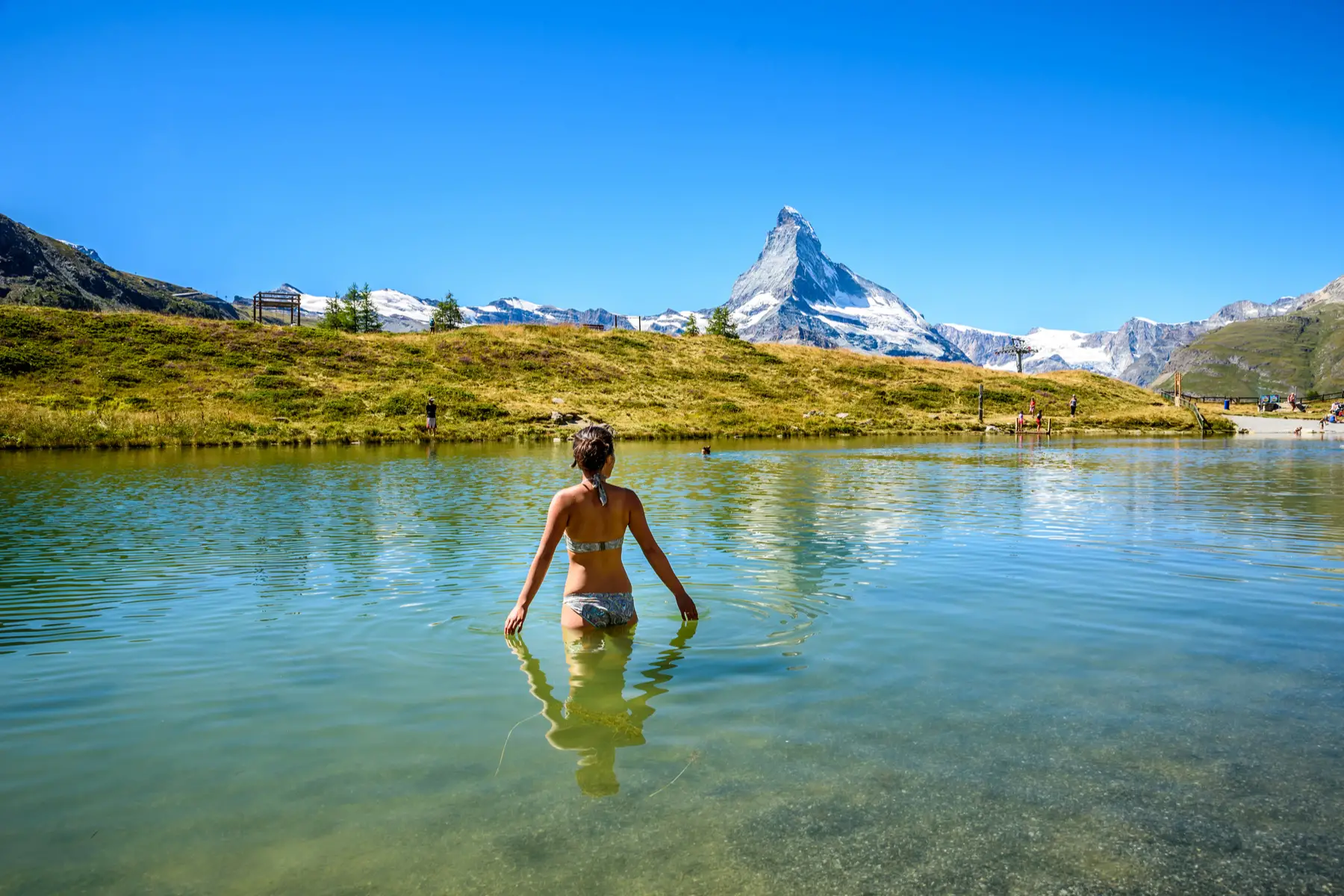
Some of the most popular summer family activities include hiking and cycling, enjoying leisurely time at public outdoor swimming areas and lakes, and relaxing in city parks.
Winter ski season
The ski season usually kicks off from mid to late November in Switzerland’s high-altitude resorts and lasts until April. This is when families head to popular mountain resorts such as Zermatt and St. Moritz. Again, school holidays generally occur over the Christmas period from late December until after Epiphany on 6 January.
Zwischenzeit (between time)
Interestingly, the period between the summer season and ski season actually has a name in Switzerland – Zwischenzeit, which literally translates to “between time”. During this period, most ski resorts are closed and the mountain towns are quiet. The cities are also pleasantly uncrowded, making this a great opportunity to explore the country without having to tackle the masses and pay peak-season prices on accommodation and attractions. Again, many Swiss schools take an Autumn break for one to three weeks during Zwischenzeit, in late September and early October.
How climate change is affecting Switzerland
Climate change is affecting every country across the globe – and Switzerland is no exception. Natural causes aside, these significant climatic alterations are believed to be the result of increasing greenhouse gas emissions. This has mostly occurred in the last three decades.

The National Center for Climate Services (NCCS) is the official Swiss government body that monitors climate change, risks, and opportunities, and mitigation measures. It expects that in the future, summers will be drier in Switzerland, and there will be more heavy storms and hotter days.
The hottest June on record
Since 1864, Switzerland has seen an increase of 2°C in the average annual temperature, and this warming trend is expected to continue. In fact, data released by MeteoSwiss in 2021 shows that seven of the ten highest average June temperatures, since records began, have occurred since 2002. With an average of 15.3°C, June 2019 was also the second hottest June ever.
Declining snowfall
The rising temperature has also had a dramatic effect on the amount of snowfall in Switzerland with major decreases being seen since the 1980s. Annual rainfall is also declining and the country is experiencing drier summers and more frequent extreme weather conditions.
Tackling climate change in Switzerland
Like many other European countries, Switzerland is committed to tackling climate change on both a national and regional level. Below are some of the key measures that the country is taking to do just this.
Reducing greenhouse gas emissions
In 2015, Switzerland pledged to reduce its greenhouse gas emissions by 50% by 2030, in line with the Paris Climate Agreement. More recently, in 2020, the country committed to increasing its contribution to the Green Climate Fund by 50% (to US$150 million) for the 2020 to 2023 period. The Fund aims to help developing countries reduce their greenhouse gas emissions and adapt to climate change.
Meanwhile, Swiss-based company Mootral is helping to reduce the large quantities of methane and nitrous oxide which are emitted by cows by producing a natural feed supplement for livestock.
Investing in renewable energy
On the flip side, Switzerland is committed to using more renewable energy and adopted the Energy Strategy 2050 in 2017. With the help of policies and regulations, it aims to rely more on renewable resources while reducing power consumption and increasing energy efficiency. The overall renewable energy production boasts a promising 75%. Moreover, the country already has a plan in motion to shut down its nuclear plants.

Helping global climate refugees
Meanwhile, through the Nansen Initiative, Switzerland is pledging to aid millions of vulnerable global climate refugees who are under threat of being displaced by climate change.
Recycle, recycle, recycle
On a more local level, recycling is mandatory in Switzerland and there are regular garbage collection days in its main cities. As a result, the Swiss boast an impressive recycling score. If you want to do your part, you can check out recycling-map.ch to find out where the nearest recycling points are.
Download the right green apps
The increasing availability of environmental apps is also making it easier to live more sustainably on a daily basis in Switzerland. From ride-sharing and renting bikes to growing your own vegetables and reducing food waste, there are countless ways to make a difference.
Useful resources
- Weather Atlas – provides a monthly weather forecast and climate overview of Switzerland
- My Switzerland – the official Swiss Tourism Board website which provides information about the weather, climate, snow reports, and webcams
- WSL Institute for Snow and Avalanche Research – up-to-date snow and avalanche conditions across Switzerland
- My Swiss Alps – offers information and tips on how to prepare for Swiss weather
- MeteoSwiss – offers a more in-depth look at climate change over the last 150 years
